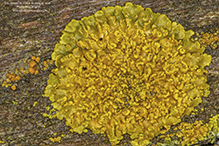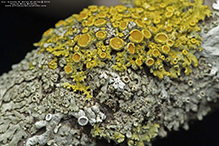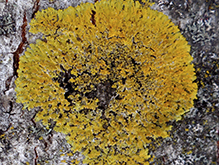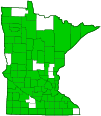Hooded Sunburst Lichen
(Oxneria fallax)
Conservation • Description • Ecology • Distribution • Taxonomy
Conservation Status |
|
|||||||
| IUCN Red List | not listed |
|||||||
| NatureServe | NNR - Unranked |
|||||||
| Minnesota | not listed |
|||||||
Description |
||
Hooded Sunburst Lichen is a widespread and very common lichen. It occurs throughout Europe and across North America. It is very common in Minnesota. It grows on bark on the trunks of deciduous trees in humid to moderately dry conditions. It rarely grows on rock or on detritus on the ground. It forms rosettes ¾″ to 1½″ in diameter that are bilaterally symmetric. Adjacent rosettes often fuse together into large colonies. The vegetative body (thallus) is leaf-like (foliose) and divided into small branches (lobes). It grows closely or loosely attached to the substrate (wood or bark) but does not have root-like structures (rhizines). The lobes are flat to convex, rounded to straight across (truncate) at the tip, and 1 ⁄32″ to 1 ⁄16″ (0.8 to 2.0 mm) wide. The upper surface is smooth to shiny and deep orange where exposed to the sun, orangish-red to reddish-orange in partially shaded areas, and pale greenish-yellow in deep shade. Tiny reproductive structures (soralia), appearing as horizontal, crescent-shaped slits, are formed on the margins at the tips of the lobes. The soralia produce powdery, greenish-yellow clusters of cells (soredia). The soredia are dispersed by wind and rain, and can form new rosettes when they land on a suitable surface. The lower surface of the thallus is white to yellow and somewhat wrinkled. Rarely there are short, white, peg-like structures (hapters) attaching the thallus to the substrate. Disk-like, spore-producing structures (apothecia) are rarely produced. When present, the disks are stalked, orange, up to ⅛″ (2.5 mm) in diameter, and shaped like a plate. They are smooth at first but often become rough and develop a ring of hairs on the margin. Each disk has a ring of tissue around it that resembles the tissue of the thallus. |
||
Similar Species |
||
Ecology |
||
Substrate |
||
Trees |
||
Growth Form |
||
Foliose |
||
Habitat |
||
Bark |
||
Hosts |
||
Deciduous trees |
||
Distribution |
||||
|
Sources |
|||
| 7/9/2022 | ||||
Occurrence |
||||
Very common and widespread |
||||
Taxonomy |
|||
| Kingdom | Fungi (Fungi) | ||
| Subkingdom | Dikarya | ||
| Phylum | Ascomycota (Sac Fungi) | ||
| Subphylum | Pezizomycotina (Sac Fungi and Lichens) | ||
| Class | Lecanoromycetes (Common Lichens) | ||
| Subclass | Lecanoromycetidae (Shield Lichens, Sunburst Lichens, Rosette Lichens, and Allies) | ||
Order |
Teloschistales (Sunburst Lichens and Allies) | ||
Suborder |
Teloschistineae | ||
Family |
Teloschistaceae (Sunburst Lichens, Firedots, and Allies) | ||
| Subfamily | Xanthorioideae | ||
Genus |
Oxneria | ||
| Mycobiont | Oxneria fallax | ||
| Photobiont | |||
This species was originally named Physcia fallax in 1858. In 1860 it was moved to Xanthoria fallax, in 2002 to Xanthomendoza fallax, and in 2003 to Oxneria fallax. Today, many sources continue to use Xanthoria fallax, but most now use Xanthomendoza fallax. Few use Oxneria fallax, though Index Fungiforum does, and that should be the last word (or at least the current word) on the subject. |
|||
Synonyms |
|||
Physcia fallax Placodium fallax Xanthomendoza fallax Xanthoria fallax |
|||
Common Names |
|||
Hooded Sunburst Lichen |
|||
Glossary
Apothecium
An open, disk-shaped or cup-shaped, reproductive structure, with spore sacs on the upper surface, that produces spores for the fungal partner of a lichen. Plural: apothecia.
Foliose
Adjective: Leaf-like growth form; referring to lichens with leaf-like growths divided into lobes.
Noun: The leaf-like, vegetative body of a lichen (thallus) that has thin, flat lobes which are free from the substrate.
Rhizine
A root-like structure of a lichen that attaches the lower layer to the substrate.
Soredium
An asexual reproductive structure of a lichen in the form of a tiny dull granule on the thallus surface that can be easily brushed off. It consists of a cluster of algal cells (the photobiont) wrapped in fungal filaments (the mycobiont), but without an outer layer of protective tissue (cortex). Plural: soredia.
Thallus
The vegetative body of a lichen composed of both the alga and the fungus.
Visitor Photos |
|||||
Share your photo of this fungus. |
|||||
| This button not working for you? Simply email us at info@MinnesotaSeasons.com. Attach one or more photos and, if you like, a caption. |
|||||
Alfredo Colon |
|||||
 |
 |
||||
Luciearl |
|||||
 |
|||||
MinnesotaSeasons.com Photos |
|||||
|
|||||

Slideshows |
||

Visitor Videos |
|||
Share your video of this fungus. |
|||
| This button not working for you? Simply email us at info@MinnesotaSeasons.com. Attach a video, a YouTube link, or a cloud storage link. |
|||
Other Videos |
|||
| Corticolous Xanthomendoza fallax Lichen Biome |
|||
About
May 11, 2020 |
|||
| Xanthomendoza fallax Top #5 Facts Rishika Janaki |
|||
About
Published on Feb 1, 2016 |
|||


Created: 5/20/2019
Last Updated:



